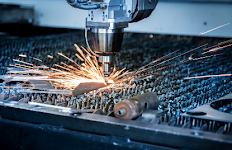Welding Arc
Most welding professes to require the application of heat for fusion which is obtained through
Flame, arc, Contact resistance, Electron beam, Laser, and Exothermic reactions.
Introduction
Since the turn of the century, much progress has been made in the field of electric arc. The electric arc is a very important industrial application such in welding, electrochemistry, electrometallurgy, lighting, and so on.Welding Arc
when an electric arc is struck, about 50% of the electrical energy fed into the arc is available as heat energy.In the field of welding, an electric arc is used as a heat source to melt base metal and consumable electrodes in order to form a strong union between the parts to be joined.
Electric welding arc besides being a heat source, transfers material, creates turbulence in the molten weld pool, influences slag-gas metal reactions, weld bead geometry, weld metal structures, and thus, in turn, the mechanical properties of the weld joints.
The discharge is initiated by an avalanche of electrons emitted from the hot cathode and maintained by the thermal ionization of the hot gas.
This electrical discharge through an amount of heat energy is employed for joining various metals and alloys by fusion.
A welding arc is a high current (up to 2000) Amps. and low compressible fluid-carrying electrical charges in a vector motion and plasma jet in purely kinetic motion.
Arc Initiation
Arc is initiated by providing a conducting path between the electrode and the workpiece or by ionizing the gap between the two. This can be achieved in the following manners: By Momently touching the electrode on the job and taking it away,
By scratching the electrode on the job. Scratching has initiated a little distance away from the point where the welding is to be started and during scratching the electrode is brought to the proper place to start the welding. These methods, though very much used in manual metal arc welding.
Steel wool, in this case, steel wool is kept pressed between the electrode and the job. When the welding current is switched on, the steel wool provides a conducting path for the arc to establish.
This method can be used in automatic submerged arc welding sets and automatic MIG welding machines. In automatic metal arc welding sets electric arc can also be initiated with the help of a carbon rod.
A suitable arc gap is kept between the electrode and the job, the current is switched on, then the electrode and job simultaneously are momentarily touched with a carbon rod.
High-Frequency Unit
In order to eliminate the chances of electrode contamination, tungsten loss, and tungsten transfer to the base metal the above methods of initiating the arcs are avoided in welding processes using tungsten or alloy tungsten electrodes. In such processes a High-frequency unit is inserted in the circuit which superimposes a high-frequency current, which jumps across the small gap between the electrodes and job, thereby establishing the arc.
Arc Structure
In a welding arc the electrons are emitted from the cathode, get accelerated in the cathode drop region, and gain energy, as they enter the arc column, they lose their energy by colliding with gas atoms and molecules which in turn get ionized like electrons and positive ions are separated.The ions and electrons then move towards cathode and anode respectively and get concentrated over there.














0 Comments
Thanks for your valuable time